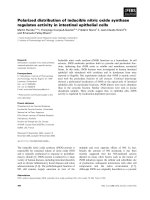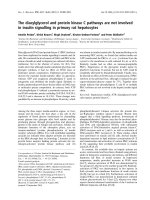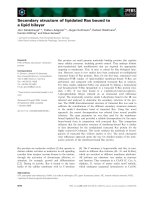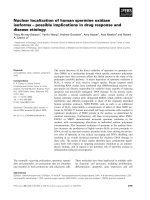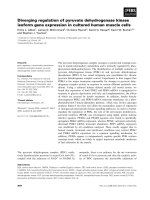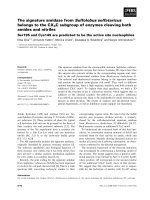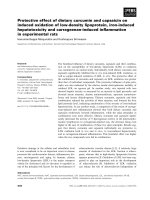báo cáo khoa học:" The effect of peer-led education on the life quality of mastectomy patients referred to breast cancer-clinics in Shiraz, Iran 2009" pot
Bạn đang xem bản rút gọn của tài liệu. Xem và tải ngay bản đầy đủ của tài liệu tại đây (233.47 KB, 7 trang )
RESEARC H Open Access
The effect of peer-led education on the life
quality of mastectomy patients referred
to breast cancer-clinics in Shiraz, Iran 2009
Farkhondeh Sharif
1*
, Narjes Abshorshori
2
, Sedigheh Tahmasebi
3
, Maryam Hazrati
4
, Najaf Zare
5
, Sarah Masoumi
6
Abstract
Background: Breast cancer among women is a relatively common with a more favorable expect ed survival rates
than other forms of cancers. This study aimed to determine the improved quality of life for post-mastectomy
women through peer education .
Methods: Using pre and post test follow up and control design approach, 99 women with stage I and II of breast
cancer diagnosis were followed one year after modified radical mastectomy. To measure the quality of life an
instrument designed by the European organization for research and treatment of cancer, known as the Quality of
Life Question (QLQ-30) and it’s breast cancer supplementary measure (QLQ-BR23) at three points in time (before,
immediately and two months after intervention) for both groups were used. The participant selection was a
convenient sampling method and women were randomly assigned into two experimental and control groups. The
experimental group was randomly assigned to five groups and peer educators conducted weekly educational
programs for one month. Tabulated data were analyzed using chi square, t test, and repeated measurement
multivariate to compare the quality of life differences over time.
Results: For the experimental group, the results showed statistically significant improvement in all performance
aspects of life quality and symptom reduction (P < 0.001), while the control group had no significant differences in
all aspects of life quality.
Conclusion: The findings of this study suggest that peer led education is a useful intervention for post-
mastectomy women to improves their quality of life.
Background
Breast cancer can be a life threatening disease for
women worldwide [1]. In Iran breast cancer consists of
22.6% of all cancers affecting women [2]. Most women
diagnosed with breast cancer are between 35 to 44 years
of age and this rate drops after the age of 44 which i s
10 years less than the western figures for women with
breast cancer [3,4]. The study by Mehrabani et al.
(2008) on cancer occurrence in the Fars Province
(southern Iran) indicated breast cancer as one of the top
10 cancers among women in a 5-years study of regis-
tered patients [5]. Surgery, chemotherapy, radiotherapy
and hormone therapy are the most common methods
for breast cancer treatment in Iran which have length-
ened the survival rate of these people. Although treat-
ments have shown some survival rate success, their
negative impacts on the quality of life are under
reported. Psychological distress, anxiety and depression
were found to be common among breast cancer
patient’ s even years after the diagnosis of the disease
and treatment (6). In a survey by Hack & D egner on
1249 women ne wly diagnosed with breast cancer, the
results showed that 32.8% had experienced psychological
distress [7].The loss of one or both breasts evoked feel-
ings of mutilation and altered body image, diminished
self-worth, loss of a sense of feminity, reduction of s ex-
ual attractiveness and function, anxiety, depression,
hopelessness, guilt, shame and fear of recurrence and
death [8]. Also Siberfarb and his colleagues c ompared
the psychosocial status in groups of breast cancer
* Correspondence:
1
Mental Health Nursing Department, Fatemeh (P.B.U.H) Faculty of Nursing
and Midwifery, Shiraz University of Medical Sciences, shiraz-Iran
Sharif et al. Health and Quality of Life Outcomes 2010, 8:74
/>© 2010 Sharif et al; licensee BioMed Central Ltd. This is an Open Access article distributed under the terms of the Creative Commons
Attribution License (h ttp://creativecommons.org/licenses/by/2.0), which permits unrestricted us e, distribution, an d reproduction in
any medium, provided the original work is properly cited.
patients during initial diagnosis (N= 50), fir st recurrence
(N = 52), and metastatic disease (N = 44). Their findings
indicated that the stage of first recurrence was the most
emotionally stressful time in their samples [9]. In this
regard Lewis & Deal in their study of 15 married cou-
ples in where the wife was diagnosed with a recurrence
of breast cancer found problems in marital adjustment
as well as depression among 40% of the women [10].
Besides these symptoms the patients suffered from pain
syndrome, lymphocyte edema, shoulder movement
restriction, and muscle atrophy[11]. Dawes et al, in a
study on 204 post-mastectomy patients found that 35%
of them had one or more symptoms of lymph edema
and they found a significant relationsh ip between pa in
and activity limitation and participation restriction [12].
A variety of intervention types such as psychological,
behavioral and formats such as group, individual and
telephone have demonstrated beneficial effect on the
quality of life, symptom management and psychological
functioning [13]. Visiting thesamepatientswiththe
same diagnosis would bring relief and assurance for
patients to overcome the disease, leading to a higher life
expectancy. When women who have breast cancer are
in touch with each other, they have empathy towards
each other and they would widely discuss their experi-
ences and difficulties creating a supportive environment
for transfer of knowledge and awareness [14]. It has
bee n reported in an observat ional study on the effect of
peer counseling on the quality of life following diagnosis
of breast cancer that women expressed the greatest need
for counseling and they wanted to speak with someone
who had the same disease and had gone through the
crisis of treatment and is leading a normal life [15].
Considering an increase in the number of breast cancer
patients and limitation in the physicians time to educate
them, this study highlights t he importance of peer-lead
education on the life quality after mastectomy for
women who experienced breast cancer and recruited
from breast cancer clinics in Shiraz, southern Iran.
Methods
Design
This is an intervention, pre-post test follow up and con-
trol group design study aiming to examine the effect of
peer-lead education on the life quality of women post-
mastectomy. The convenience and a purposeful sam-
pling method helped randomly divide the participants
into two experimental and control groups. All the
patients met the inclusion criteria as stage I or II breast
cancer diagnosis, having had modified radical mastect-
omy, at least 1 years after their mastectomy, completed
chemotherapy and radiotherapy, and currently under
hormone therapy. Exclusion criteria were having other
types of malignancy or psychiatric disorder. To obtain
sufficient statistical power in detecting differences
between the groups and to predict the study outcomes
between the two groups with significa nce of (p < 0.05),
one hundred women were selected. They were randomly
assigned into experimental and control groups. Of the
experimental group one person discontinued leaving
49 patients in the experimental group and 50 in the
control group.
The quality of life was measured using the European
organization for research and treatment of cancer qual-
ity of life question (QLQ-30) and i ts breast cancer sup-
plementary measure (QLQ-BR23) at three points in
time: before, immediately, and two months after the
intervention in both groups. The instrum ent was admi-
nistered blindly by the researcher. The instrument
developed by the European Organization for research on
the quality of life for cancer pat ien ts (EORTC QLQ- 30)
consists of functional and symptomatic scales. The func-
tional scales consist of the general health condition,
physical function, m ental function, psychological func-
tion and the social function. The symptomatic scales
consists of fatigue, sickness and vomiting, pain, dispen d,
insomnia, loss of appetite, constipation, diarrhea and
economical problems, each one consisting of a number
of questions. The questionnaire by the European organi-
zation for research and treatment of cancer (QLQ-
BR23) is merely specialized for bre ast cancer and mea-
sures the life quality of patients suffering from breast
cancer. This questionnaire evalua tes four functional
aspects and four sets o f common sy mpt oms in patie nts
suffering from cancer. It consists of mental conception
of the body, sexual function, sexual function satisfaction,
and attitude towards future, side effects of systemic
treatments, side effects in the patient ’ s breast and hand
and worries about hair loss. The score of each aspect is
based on a scale o f 0 to 100. In functional and general
aspects of life quality a higher score shows a better
functional condition or a better life quality whereas, in
the symptoms aspect, a high score is a sign of problem.
Validity and reliability of its Persian (Farsi) script was
assessed by Montazeri et. al. (1999) in Iran and it was
introduced as a valid and reliable tool by the European
organization for research and treatment of cancer
[16,17]. The collected data were analyzed by SPSS soft-
ware, Chi-square tests, independent T-test and the
repeated measurement multivariate tests for measuring
life quality in three different time periods.
The experimental group was divided into five sub-
groups of ten patients and carried on in two stages. In
the first stage and based on the patient’s physician’s opi-
nion 5 of the patients who were in stages I and II of the
illness with at least five years remission post-mastect-
omy and able to communicate with others were selected
as the peer educators. Their training was about the
Sharif et al. Health and Quality of Life Outcomes 2010, 8:74
/>Page 2 of 7
concept o f cancer, breast cancer, diagnosis, treatment,
complications, self care, relaxation techniques and adap-
tation to the illness. The training was performed in 4
sessions and each session lasted for one hour. The train-
ing sessions for peer educators were conducted by
experts in the psycho-oncology f ield. In the second
stage these peer educators were asked to go to the
groups and after needs assessment, guide the group in a
friendly environment. For each group peer educators
conducted 4 sessions on a weekly basis for one month.
Each session lasted approximately 1 h our and started
with refreshment and continued with discussion about
the topics acco rding to the group’s need. The control
group did not receive any intervention and after the last
stage of data collection they received an educational
pamphlet.
Institutional Review Board (IRB) a pproval for the
study was obtained from the Ethics Committee of Shiraz
University of Medical Sciences (ECSUMS ). Written con-
sent was obtained from each patient. The purpose of
study, voluntary participation, confidentiality and free-
dom to discontinue at any time was reviewed. The study
was carried out in the only breast cancer clinic in Shiraz
in Fars province at southern Iran. This is the largest
clinic in Fars Province which is affiliated with Shiraz
University of Medical Sciences. This center offers ser-
vices (treatment and follow up) to at least 50 patients
on a daily basis.
Results
The collected data were an alyzed using SPSS software,
Chi-square tests, independent T-test and the repeated
measur ement multivariate tests for assessing life quality
in three different time periods. Table 1, presents the
demographic and baseline characteristics of the e xperi-
mental and control groups. The results revealed that the
experimental and control groups were similar with
respect to age, marital status and educational level of
the patients. The majority of the participants were aged
between 40 to 49 years (32.7% in the experimental
group and 40% in t he control group), and most of them
were married (88.8% in the experimental group and 90%
in the control group). There was no significant differ-
ence in the demographic variables between the two
groups.
Assessing the results before interventions with the
independent T-test showed that the two groups were
similar in almost all of the functional and symptomatic
scales of quality of life regar ding cancer and b reast can-
cer and there was no statistically significant difference
between the two groups before intervention.
In comparing the patients’ functioning and global life
quality before and after intervention which was mea-
suredbytheEORTCQLQ-C30theresultswhile
considering the mutual effect of time and group indi-
cated significant improvement in the experimental
group and a reduction in the control group’sfunction.
Time was a significant factor for change in the experi-
mental and control groups in aspects such as general
health condition, psychological function, and social
function, mental function of life quality regarding cancer
and the body image, sexual f unction, and satisfaction
with the sexual function regarding the breast cancer
patients’ life quality. However, in general, regardless of
time there was no significantdifferencebetweenthe
experimental and control groups (P = 0.208). No specific
difference was seen in the physical function before to
two months after intervention and thus it seems that
time was not a significant factor for change in this
aspect (P = 0.777). The experimental group’ sfunction
accelerated and the control group’s function decreased
(P = 0.041) (Table 2)
Comparison of the patients’ symptom, the mean
score from pre to post and follow up intervention indi-
cated the change process regarding fatigue and insom-
nia from the quality of life in relation to cancer. Also,
the side effects of systemic treatments in the control
group differed from the quality of life in relation to
cancer. Exactly after the intervention and two months
after it the symptomatic scales indicated a decline in
4 aspects including fatigue, Pain, insomnia and loss of
appetite (it is shown in Table 3 with *) in the experi-
mental group and an increased in the c ontrol group.
Time was a significant factor for change in these
Table 1 Demographic Characteristics of the study sample
in groups
No (%) Experimental
Group
No (%) Control
Group
p
Age Groups
(Years)
30-39 10(20.4) 7(14)
40-49 16(32.7) 20 (40) 0.810
50-59 14(28.6) 14(28)
60-70 9(18.4) 9 (18)
Educational
Level
Below Diploma 27(55.1) 26(52)
Above Diploma 22(44.9) 26(52) 0.528
Marital Status
Single 3(6.1) 2(4)
Married 43(88.8) 45(90) 0.889
Divorced or
widow
3(6.1) 3(6)
Total 49 (100) 50 (100)
Sharif et al. Health and Quality of Life Outcomes 2010, 8:74
/>Page 3 of 7
aspects and these changes were more evident in the
experimental group in decreasing the symptoms (P <
0.001). Generally, regardless of time there was no sig-
nificant difference between the experimental and con-
trol groups regarding fatigue (P = 0.149), insomnia (P
= 0.547) and the side effects of systemic treatments.
Regarding aspects such as nausea and vomiting (P =
0.320), constipation (P = 0.076), economical condition
(P = 0.608) and dyspnea (P = 0.167), time was not a
significant f actor for change (Table 3).
In comparing the mean score of the functional scale
from pre to post and follow up intervention in groups
as measured by EORTC QLQ-BR23, the results indi-
catedanincreaseinalltheaspectssuchasbodyimage,
sexual function, sexual satisfaction and future perspec-
tive in the experimental group (P < 0.001) and a
decrease in all those aspects of life quality in the control
group (Table 4)
In comparing the mean score of symptom scale from
pre to post and follow up intervention in groups as
Table 2 Functioning and Global quality of life mean scores in groups before and after the intervention (as measured
by the EORTC QLQ-C30)
Functioning Scores Time Before intervention After intervention 2 months after intervention Time Group Time/group
Groups Mean ± SD Mean ± SD Mean ± SD P
Global health status Case 63.09 ± 22.69 68.19 ± 19.06 80.0 ± 17.90 * * *
Control 62.16 ± 22.02 61.83 ± 22.02 61.66 ± 21.88 .001 .o37 .001
Physical functioning Case 79.72 ± 18.55 80.54 ± 17.83 80.81 ± 16.02 .777 .425 *
Control 83.26 ± 13.41 82.58 ± 13.37 82.27 ± 13.32 .041
Role functioning Case 85.37 ± 21.95 87.75 ± 18.24 98.63 ± 5.72 * *
Control 86.80 ± 19.73 86.45 ± 20.23 85.06 ± 20.69 .001 .208 .001
Cognitive functioning Case 72.78 ± 23.24 85.71 ± 15.21 97.75 ± 5.52 * * *
Control 70.74 ± 23.20 70.40 ± 23.14 69.38 ± 24.13 .001 .001 .001
Emotional functioning Case 63.94 ± 29.23 85.37 ± 13.45 97.10 ± 4.97 * * *
Control 61.90 ± 25.45 60.71 ± 24.65 60.20 ± 24.73 .001 .001 .001
Social functioning Case 81.97 ± 18.89 91.15 ± 13.22 99.65 ± 2.38 * * *
Control 81.97 ± 20.92 80.27 ± 20.032 78.57 ± 22.30 .001 .001 .001
The higher value indicate higher level of functioning and quality of life, min: 0, max: 100
Table 3 Means scores of Symptoms of life quality in groups before and after the intervention (as measured by the
EORTC QLQ-C30)
Symptom Scores Time Before intervention After intervention 2 months after intervention Time Group Time/group
Groups Mean ± SD Mean ± SD Mean ± SD P
Fatigue Case 25.62 ± 19.00 19.04 ± 15.87 8.61 ± 12.88 * .149
Control 22.44 ± 21.35 23.11 ± 21.62 23.77 ± 21.99 .001 .001
Nausea and vomiting Case 20.76 ± 18.36 19.95 ± 17.68 17.00 ± 19.09 *
Control 12.33 ± 20.42 11.00 ± 18.93 11.33 ± 19.17 0.297 .116 .320
Pain Case 21.42 ± 23.07 20.40 ± 22.63 19.04 ± 21.24 *
Control 23.80 ± 24.05 24.82 ± 24.56 24.79 ± 85.06 .247 .386 .039
Insomnia Case 31.29 ± 35.62 21.76 ± 25.04 10.88 ± 18.49 * .547 *
Control 16.00 ± 27.13 16.66 ± 29.35 17.33 ± 27.13 .001 .001
Appetite loss Case 7.48 ± 19.56 4.08 ± 12.96 .680 ± 4.76 *
Control 4.08 ± 14.64 5.44 ± 18.44 6.1 ± 21.16 .1840 .711 .005
Constipation Case 29.93 ± 36.79 30.61 ± 37.16 28.57 ± 35.35 .247 .146 .076
Control 18.05 ± 30.71 20.83 ± 31.97 20.13 ± 32.06
Dyspnea Case 7.48 ± 17.03 6.12 ± 14.7 5.42 ± 14.18 .814 .373 .167
Control 8.66 ± 14.76 9.33 ± 16.55 10.00 ± 16.83
Financial difficulties Case 36.11 ± 34.26 38.19 ± 35.05 36.80 ± 33.14
Control 33.33 ± 32.25 34.72 ± 32.94 35.41 ± 33.26 .132 .707 .608
The higher values indicate a greater degree of symptoms, min: 0 max: 100
Sharif et al. Health and Quality of Life Outcomes 2010, 8:74
/>Page 4 of 7
measured by EORTC QLQ-BR23 in time process, con-
sidering the mutual effect of time and group, the resu lts
indicated a decrease in symptoms in two aspects of
breast symptom (0.032) and upset by hair loss (0.049) in
the experim ental group 2 months after the intervention
and there was an increase in symptoms in the control
group 2 months after the intervention (Table 5).
Generally regardless of time there was no significant
difference between the two groups regarding those
aspects?
Discussion
The study results show that the peer lead education is
an effective approach to improve the life quality of mas-
tecto my patients. This study evaluated the life quality of
99 breast cancer patients using standard life quality
assessment tools. The results of the current study indi-
cated an increase in the life quality related to breast
cancer before to two months after intervention and sup-
port. The outcome of this study verifies the effect of
peer lead education on life quality for cancer patients.
No significant changes were found in the life quality of
the control group. In aspects such as general health,
psychological function, social function, mental function
and role function i ncreased in the experimental group
two months after the intervention. Several reviews have
concludedthatpsychosocial interventions have a posi-
tive impact on the well-being of breast cancer pa tients.
To date, research has not established whether one kind
of intervention is more effective than another but a vari-
ety of intervention types have demonstrated beneficial
effects. Many women ne ed to participate in breast can-
cer support groups to cope with their illness. According
to Till (2003), support group and a navigator to support
the breast cancer women play an important role in
improved quality of life as women need to depend on a
source in relation to b reast cancer. So assi stan ce in var-
ious phases needs to be taken in to account in an effort
to evaluate the “ navigator role” [18]. Although the
empiric evidence points to the community-based sup-
port groups as beneficial, but other studies have not
reported substantial outcomes. In Cook Gotay study on
the impact of a p eer-Delivered Telephone Intervention
on women experiencing a breast cancer recurrence, the
results showed that it did not lead to better psychosocial
outcomes [19].
In contrast, Liberman’ s study results (2003) showed
participation in the peer education program lead to
an improvement in the social-psychological functions in
women diagnosed with breast cancer [20]. Also,
Table 4 Functioning Scores mean of life quality in groups before and after the intervention (as measuredby the
EORTC -BR23)
Functioning Scores Time Before intervention After intervention 2 months after intervention Time Group Time/group
Groups Mean ± SD Mean ± SD Mean ± SD P
Body image Case 68.19 ± 25.21 82.14 ± 14.29 93.87 ± 6.31 * * *
Control 73.33 ± 24.51 72.33 ± 23.35 71.00 ± 23.21 .001 .022 .001
Sexual function Case 27.13 ± 16.27 43.02 ± 15.09 64.34 ± 13.88 * * *
Control 24.63 ± 19.48 23.91 ± 18.80 19.35 ± 22.82 .001 .001 .001
Sexual enjoyment Case 26.82 ± 18.58 46.34 ± 19.54 76.42 ± 18.62 * * *
Control 22.48 ± 22.67 21.70 ± 22.86 20.15 ± 23.16 .001 .001 .001
Future perspective Case 47.61 ± 32.6 62.58 ± 25.12 88.43 ± 17.41 * * *
Control 57.14 ± 35.35 54.42 ± 33.81 51.02 ± 32.70 .001 .040 .001
Table 5 Means scores of Symptoms of life quality in groups before and after the intervention (as measured by the
EORTC-BR23)
Symptom Scores Time Before intervention After intervention 2 months after intervention Time Group Time/group
Groups Mean ± SD Mean ± SD Mean ± SD P
Systemic therapy side effects Case 21.82 ± 16.46 12.79 ± 10.63 3.67 ± 4.19 * .185 *
Control 16.79 ± 18.87 17.04 ± 19.19 17.29 ± 19.69 .001 .001
Breast symptoms Case 18.87 ± 18.92 18.70 ± 18.90 17.51 ± 19.41
Control 13.60 ± 15.28 13.94 ± 15.53 14.28 ± 15.77 .404 .209 .032
Arm symptoms Case 31.97 ± 26.02 31.74 ± 25.15 31.06 ± 24.53
Control 24.44 ± 18.51 24.88 ± 18.45 24.66 ± 18.55 .532 .120 .246
Upset by hair loss Case 12.69 ± 19.65 11.11 ± 16.10 9.52 ± 18.68 *
Control 12.28 ± 25.36 14.03 ± 25.61 15.78 ± 25.74 .992 .665 .049
Sharif et al. Health and Quality of Life Outcomes 2010, 8:74
/>Page 5 of 7
Cappiello (2007) believe that patients experience many
physical disorders as time goes on and they need sup-
port and help to cope with their condition [21].
The results of this study reflect a reducti on in fatigue,
anorexia and insomnia two months after the interven-
tion. In C lark et al.’s study (2003) on the patients w ho
were undergoing radio-therapy there was a reduction in
depression, anxiety, loneliness and physical symptoms
such as anorexia, gastro-intestinal disorder and fatigue
after participating in peer support groups in the experi-
mental group a s compared to the control group [22].
The body image, sexual function, satisfaction in sexual
performance and attitude towards the future in the
experimental group improved two months after the
intervention. Ganz et al. (2000) introduce fatigue, anxi-
ety, disorder in the b ody image, sexual i ssues and com-
plication in the patients’ hand as the most common
factors reducing the quality of life in these patients [23].
Hence, the body image, sexual function and satisfaction
with the sexual performance are common problems
which women experience after mastectomy. In this
study the sexual function and satisfaction showed a
great change two months after the intervention when
compared to before the intervention (p < 0.001), while
in Hazrati et al.’s study (2008)there was no improvement
in the patients’ sexual funct ion [24]. It seems the differ-
ence relates to the intervention method. The researchers
believe that culture is an inflectional factor in sexual
issues and body-image. Also Fobair (2006) believes that
Asian women do not like to talk about their sexual
issues and consider it shameful and irrational [25].
Ther efore, intervention techn iques influences women to
talk freely about their sexual concerns in groups and
find a personal for better sexual function and satisfac-
tion. The results of this study are similar to those of
Matthews’ research (2002) who state s that patients ben-
efit from talking to each other about their sexual issues
and generally find more satisfaction in their life [26]. It
seems that the peer group method and group counseling
is more effective for improving the sexual function
because they can talk without shame about their sexual
issues in a more relaxed environment.
Regarding t he physical function and complications in
the breast cancer patient’s arm, no significant differences
were seen in the exper iment al group 2 months after the
intervention. Lash et al. (2002) in their study showed
that the surgical symptoms worsen during the first year
after surgery without physiotherapy and breast cancer
care [27]. The results of Hazrati et al.’s study (2008) also
proves this issue, indicating that these patients need to
participate in physiothera py sessions to improve their
physical function and reduce symptoms in their arm
and breast as well as participate in the educational
sessions. Therefore it seems that participating in phy-
siotherapy sessions alongside peer support is effective
[24]. Cadmus et al.’s study (2009) reveals that exercise
alone is not effective in breast cancer patients’ quality
of life, although it improves the social function in trea-
ted cancer patients [28]. Therefore lack of improve-
ment in the physical function and the existence of
complication in the patients’ hand in the experimental
group may be the result of not following the care
instructions for the hand, not doi ng organized fitness
exercises and not participating in physiotherapy
sessions in the peer groups. Generally, it can be con-
cluded that the life quality of the women who partici-
pated in peer group education was considerably higher
compared to those who did not participate in the
sessions. Strong support was reported in Patenaude et
al.’ s study (2008) from 25 healthy women who had
undergone bilateral prophylactic mastectomy and 45
women unilateral prophylactic mastectomy, for the
emotional and informational value of speaking with a
woman who had previously undergone prophylactic
mastectomy [29]. In the current study the majority of
participants recognized that peer education was effec-
tive and they were willing to participate in all sessions.
Therefore, it is recommended that peer education pro-
gram should be included as part of the patients’ treat-
ment program with the aim of reducing the symptoms
of cancer and improving the quality of l ife.
Conclusions
Theresultsofthisstudyprovideempiricalevidence
about the benefits of incorporating peer-led education
in improving the life quality for post-mast ectomy
patients. It is anticipated our findings will contribute to
delegating caring responsibility to these patients and
facilitating the establishment of a counseling center in
the breast cancer clinics. Overall breast can cer patients
greatly benefited from peer group support to i mprove
their quality of life.
Abbreviations
EORTC QLQ-C30: European Organization for Research and Treatment of
Cancer Quality Questionnaire-Cancer 30; EORTC QLQ-BR23: European
Organization for Research and Treatment of Cancer Quality of Life Breast
Cancer Questionnaire.
Acknowledgements
The authors would like to thank the director of Mottahari Breast Cancer
clinic in Shiraz (Dr Talei) and director of Chemotherapy center in Nemazee
hospital (Dr Mohamadi) and all the personnel for their valuable help and
cooperation. Also the authors would like to acknowledge all the patients for
their active contribution and participation in this research. The authors
would also like to thank the vice-chancellor for research at Shiraz University
of Medical Sciences for the financial support and approval of this M.Sc.
dissertation proposal and Dr. Shokrpour, professor of the linguistics
department for final editing the manuscript.
Sharif et al. Health and Quality of Life Outcomes 2010, 8:74
/>Page 6 of 7
Author details
1
Mental Health Nursing Department, Fatemeh (P.B.U.H) Faculty of Nursing
and Midwifery, Shiraz University of Medical Sciences, shiraz-Iran.
2
Nursing
Department, Faculty of Nursing affiliated to Shiraz University of Medical
Sciences, Larestan - Iran.
3
Department of Surgery, Shiraz University of
Medical Sciences, Shiraz-Iran.
4
Medical Surgical Nursing Department,
Fatemeh (P.B.U.H) Faculty of Nursing and Midwifery, Shiraz University of
Medical Sciences, Shiraz, Iran.
5
Shiraz University of Medical Sciences,
Department of Biostatistics, Faculty of Medicine, Shiraz-Iran.
6
Iranian Journal
of Medical Sciences Office, Shiraz University of Medical Sciences, Shiraz-Iran.
Authors’ contributions
FSH was the main investigator, coordinating the research and writing the
paper. NA was responsible for data collection and contributed to the data
analysis. MH assisted in the study design and coordinated the research. ST
helped for interviewing the patients and introduced them for intervention.
NZ did the data analysis and give statistical advice. All the authors read and
approved the final manuscript.
Competing interests
The authors declare that they have no competing interests.
Received: 20 February 2010 Accepted: 23 July 2010
Published: 23 July 2010
References
1. Hervy M, et al: Effect of group counseling on patients’ sexual health.
Journal of Forensic Medicine 2005, 4:201-206.
2. Aghaberary M, Ahmadi F, Mohamadi E, Haji Zadeh E, Farahani A: Physical
and psycho-social aspects of life quality in breast cancer patients
undergoing chemotherapy. Iranian Journal of Nursing research 2005,
3:55-65.
3. Taleghani F, ParsaYekta Z, Nikbakht Naserabadi A: Adjustment process in
Iranian women with breast cancer. J Nursing cancer 2008, 31(3):32-41.
4. Harrirchi I, Ebrahimi M, Zamani N, et al: Breast cancer in iran : A review of
experimental 903 experimental records. Public Health 2000,
114(2):143-145.
5. Mehrabani D, et al: Cancer occurrence in Fars Province, Southern Iran.
Iranian Red Crescent Journal 2008, 10(4):314-322.
6. Ream E, Richardson A, Dann CA: Facilitating patient’s coping with fatigue
during chemotherapy-pilot outcomes. Cancer Nursing 2002, 25(4):300-308.
7. Hack TF, Degner LF: Coping responses following breast cancer diagnosis
predict psychological adjustment three years later. Psycho-Oncology 2003,
13(4):235-247.
8. Kunkel E, Emmie C, Titus O: Psychological and sexual well being,
philosophical/spiritual views, and health habits of long-term cancer
survivors. Health Care for Women International 2002, 16:253-262.
9. Silberfarb PM, Maurer H, Crouthamel CS: Psychological aspects of
neoplastic disease: Functional status of breast cancer patients during
different treatment regimes. American Journal of Psychiatry 1980,
137:450-455.
10. Lewis FM, Deal LWE: Balancing our lives: A study of the married couple’s
experience with breast cancer recurrence. Oncology Nursing Forum 1995,
22:934-935.
11. Rudy RR, Rosensonfeld LB, Galassi JP: Participants perceptions of a peer -
helper, Telephone - based social support intervention for melanoma
patients. Health common 2001, 13:285-305.
12. Dawe D, Meterissian S, Goldberg M, Mayo N: Impact of lymphoedema on
arm function and Health related quality of life in women following
breast cancer surgery. J Rehabilitation Med 2008, 40:651-658.
13. Charles A, Coltman Jr: Enhancing Well-Being during Breast Cancer
Surgery. U.S. CTRC Research Foundation 2001, 5-11.
14. Taleghani F, parsa yekta Z, Nikbakht naserabadi A: Coping with breast
cancer in newly diagnosed Iranian women. Journal of Advanced nursing
2006, 54(3):265-273.
15. Davis JG, Isberg C, Carson K, et al: The effect of peer counseling on
quality of life following diagnosis of breast cancer: an observational
study. Psycho-Oncology 2006, 15(11):1014-1022.
16. Montazeri A, Harirchi I, Vahdani I, et al: The European organization for
research and treatment of cancer quality of life questioner. Support care
cancer 1999, 7:400-406.
17. Montazeri A, Harirchi I, Vahdani I, et al: The EORTC breast cancer-specify
quality of life questionnaire, quality of life research. quality of life research
2000, 9:177-184.
18. Till JE: Evaluation of support groups for women with breast cancer:
Importance of the navigator role. Health and Quality of Life Outcome 2003,
1:16.
19. Cook C, Moinpour C, Unger J, et al: Impact of a peer-delivered telephone
intervention for women experiencing a breast cancer recurrence. Journal
of Clinical Oncology 2007, 25(15):2093-2099.
20. Lieberman M, Glant J, Davis A: Electronic support group for breast
carcinoma: clinical trial effectiveness. Cancer J 2003, 97(4):920-925.
21. Cappillo M, Regina S, Cunningham M, et al: Breast cancer survivors:
information and support after treatment. Clin Nurs Res 2007, 16:278-93.
22. Clark M, Bostwick M, Rummans T: Group and individual treatment
strategies for distress in cancer patients. Mayo clin proc 2003,
78:1538-1543.
23. Ganz PA: Quality of life across the continuum of breast cancer. Breast
Journal 2000, 6:324-330.
24. Hazrati M, et al: Effect of rehabilitation on life quality of mastectomy
patients. Armaghan Danesh Journal 2008, 4:9-19.
25. Fobair P, Stewart Chang s: Body image and sexual problems in young
women with breast cancer. Psycho-oncology 2006, 15:579-594.
26. Matthews BA, Baker Fand Hann D: Health Status and life satisfaction
among breast cancer survivor peer support volunteers. Psycho-oncology
2002, 199-211.
27. Lash LT, Silliman RA: Long term fallow-up of upper body function among
breast survivors. Breast J 2002, 8:28-33.
28. Cadmus LA, Salovey P: Exercise and quality of life during and after
treatment for breast cancer: result of two randomized controlled trials.
Psycho-oncology 2009, 18:343-352.
29. Patenaude A, Orozco S, Li X, et al: Support needs and acceptability of
psychological and peer consultation: attitudes of 108 women who had
undergone or were considering prophylactic mastectomy. Psycho-
Oncology 2008, 17:831-843.
doi:10.1186/1477-7525-8-74
Cite this article as: Sharif et al.: The effect of peer-led education on the
life quality of mastectomy patients referred to breast cancer-clinics in
Shiraz, Iran 2009. Health and Quality of Life Outcomes 2010 8:74.
Submit your next manuscript to BioMed Central
and take full advantage of:
• Convenient online submission
• Thorough peer review
• No space constraints or color figure charges
• Immediate publication on acceptance
• Inclusion in PubMed, CAS, Scopus and Google Scholar
• Research which is freely available for redistribution
Submit your manuscript at
www.biomedcentral.com/submit
Sharif et al. Health and Quality of Life Outcomes 2010, 8:74
/>Page 7 of 7


